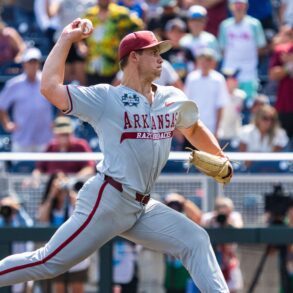That at least seems to be the prevailing public sentiment on Tennessee picking up Carlson, a shortstop/righthander who is the No. 5 player in the 2025 high school class.
It’s true that Carlson’s talent makes him a potential first-round pick if the MLB draft were tomorrow. The same goes for fourth-ranked Kruz Schoolcraft, an uncommitted lefthander/first baseman who is 6-foot-8, 225 pounds with recent visits to Tennessee, Texas A&M, Oregon State and Florida.
But the draft isn’t tomorrow, it’s in July. A lot can change in eight months.
So, how often do an elite high school prospects make it to campus? Let’s look at what the data shows from recent classes.
Our coverage of high school underclass players has grown significantly over the last few years. Right after the draft has ended the last three cycles, we have released an updated ranking of the top 100 players in the high school class for the following year. So for the 2023 and 2024 classes, we have data on the top 100 players one full year out from their draft and whether they signed or went to college.
That mid-July time period is early in the summer for major league scouts, whose main focus is still on the current’s year’s draft. So those rankings happen before big events later on the circuit like East Coast Pro, the Area Code Games, some of the big All-American events and the WWBA World Championship in Jupiter, Fla. that plays every October.
It’s not the exact time frame we’re looking at now with a player like Carlson or Schoolcraft, but we can look at those lists and answer an important question: One year out from the draft, how often does a top high school prospect end up signing out of the draft the next summer?
Let’s look at the data from the 2023 and 2024 classes individually, then at the combined results. We can bucket players into different groups based on where they fall on the list:
- Top 10 players
- Top 25 players
- Players 26-50
- Players 51-100
Now let’s look at the results of those tiers and the list of the top 25 players in those classes one year out from their draft.
2023 Class
- Top 10 players: 2 of 10 (20%) went to college
- Top 25 players: 10 of 25 (40%) went to college
- Players 26-50: 15 of 25 (60%) went to college
- Players 51-100: 40 of 50 (80%) went to college
- Top 50 overall: 25 of 50 (50%) went to college
- Top 100 overall: 65 of 100 (65%) went to college
When the numbers ended up looking that clean, it made me check the results several times over, but that is how it lined up.
The only two top 10 players who got to college were shortstop Dylan Cupp, who started 21 games at Mississippi State in 2024, and catcher Campbell Smithwick, a strong Ole Miss commit who went to high school eight minutes from Swayze Field and played in 30 games for the Rebels as an 18-year-old.
Among top 50 players who went to college, Texas A&M third baseman Gavin Grahovac and LSU infielder Steven Milam (No. 26) were both Freshman All-Americans, while Tre Phelps (No. 37) made the Freshman All-American second team.
Even among the top 25 players in a class one year out from the draft, there were 40% who made it to college and a 50/50 chance of a top 50 player going to school, though the odds were lower for the highest ranked players.
Top 25 Players For 2023
| Rk | Player | Pos | Pro/College |
| 1 | Max Clark | OF | Pro |
| 2 | Walker Jenkins | OF | Pro |
| 3 | Kevin McGonigle | SS | Pro |
| 4 | Dylan Cupp | SS | College |
| 5 | Thomas White | LHP | Pro |
| 6 | Antonio Anderson | SS | Pro |
| 7 | Eric Bitonti | SS | Pro |
| 8 | Aidan Miller | 3B | Pro |
| 9 | Noble Meyer | RHP | Pro |
| 10 | Campbell Smithwick | C | College |
| 11 | Blake Mitchell | C | Pro |
| 12 | Gavin Grahovac | 3B | College |
| 13 | Bryce Eldridge | 1B/RHP | Pro |
| 14 | Roch Cholowsky | SS | College |
| 15 | Travis Sykora | RHP | Pro |
| 16 | Charlee Soto | RHP | Pro |
| 17 | Roman Martin | SS | College |
| 18 | Cameron Johnson | LHP | College |
| 19 | Braden Holcomb | SS | College |
| 20 | Aidan Keenan | RHP | College |
| 21 | Colt Emerson | SS | Pro |
| 22 | Zander Mueth | RHP | Pro |
| 23 | Ryder Helfrick | C | College |
| 24 | Ralphy Velazquez | C | Pro |
| 25 | Derek Schaefer | RHP | College |
2024 Class
- Top 10 players: 7 of top 10 (70%) went to college
- Top 25 players: 15 of 25 (60%) went to college
- Players 26-50: 15 of 25 (60%) went to college
- Players 51-100: 41 of 50 (82%) went to college
- Top 50 overall: 30 of 50 (60%) went to college
- Top 100 overall: 71 of 100 (71%) went to college
The results are a little messier with the 2024 class. The 2023 high school class was loaded, while we said for years that 2024 lacked typically-elite talent at the top. A year out from that draft, it felt like Konnor Griffin was the only player who was a high-probability first-round pick, and it continued to play out that way. Griffin went No. 9 overall to the Pirates as the only high school player in the top 10 and was one of just two high school players in the top 15 picks, even against a college class that was not particularly strong either.
The 2024 class was more muddled, but that’s mainly because of the top 25 players. The results are almost identical in the 26-50 groups for 2023 (60%) vs. 2024 (60%) and the 51-100 groups for 2023 (80%) vs. 2024 (82%).
That makes me feel more confident that the college vs. pro outcomes we will see for players in the 26-100 range will hold consistent going forward. Some classes are deeper than others, and you can feel it in the quality of players toward the back of the top 100, but usually the biggest differences in quality are in the caliber of players in the top 10 or top 25 players.
What happened at the top though? I think it’s a few things:
• The 2024 high school class lacked premium talent that made it hard to separate the top players a year out from the draft, especially relative to the 2023 class. Looking ahead, the 2025 class is better than 2024 and the 2026 class could be the best since 2023.
• There were some high-profile players ranked in the top 10 in 2024 who are good prospects that MLB teams liked but just didn’t draft for different reasons. Outfielder Derek Curiel (LSU) pulled his name out of the draft, though he would not have been a first-round pick had he stayed. Shortstop Charlie Bates (Stanford) and righthander Tegan Kuhns (Tennessee) were both top 100 overall draft prospects who had strong commits and high price tags, with Curiel and Kuhns both old enough to be draft-eligible sophomores in 2026. In the 11-25 range, righthander William Schmidt was the No. 2 high school pitcher on our draft board, but the day of the draft, he told teams not to pick him because he was going to LSU.
• I’m the one doing the rankings, so I have to point the finger at myself here and say that I did a better job lining up the top of the 2023 class than I did with the 2024.
Top 25 Players For 2024
| Rk | Player | Pos | Pro/College |
| 1 | Konnor Griffin | SS | Pro |
| 2 | Derek Curiel | OF | College |
| 3 | Owen Paino | SS | College |
| 4 | PJ Morlando | OF | Pro |
| 5 | Michael Mullinax | OF | College |
| 6 | Bryce Rainer | SS | Pro |
| 7 | Cade Arrambide | C | College |
| 8 | Brendan Lawson | SS | College |
| 9 | Charlie Bates | SS | College |
| 10 | Tegan Kuhns | RHP | College |
| 11 | Cam Caminiti | LHP | Pro |
| 12 | JD Dix | SS | Pro |
| 13 | Bryce Clavon | SS | College |
| 14 | Joey Oakie | RHP | Pro |
| 15 | Casan Evans | RHP | College |
| 16 | Levi Clark | C | College |
| 17 | William Schmidt | RHP | College |
| 18 | Owen Hall | RHP | Pro |
| 19 | Theodore Gillen | SS | Pro |
| 20 | Noah Franco | OF/LHP | College |
| 21 | Anson Seibert | RHP | College |
| 22 | Chase Mobley | RHP | Pro |
| 23 | Carson Wiggins | RHP | College |
| 24 | Slade Caldwell | OF | Pro |
| 25 | Erik Parker | SS | College |
Combined Data
- Top 10 players: 9 of 20 went to college (45%)
- Top 25 players: 25 of 50 went to college (50%)
- 26-50 players: 30 of 50 went to college (60%)
- 51-100 players: 81 of 100 went to college (81%)
- Top 50 overall: 55 of 100 went to college (55%)
- Top 100 overall: 136 of 200 went to college (68%)
What To Expect Moving Forward
I would bet the results of the 26-50 and 51-100 groups will probably continue to hold true. For top 10 and top 25 prospects, we can look at the overall average as a guideline, but it may be better to look at 2023 and 2024 as the potential distribution of outcomes given the disparity in quality of those classes. The group of the top 10 prospects is smaller than the No. 26-50 or the No. 51-100 players, so that smaller sample should be subject to more variance. It might hold true that a top 25 player one year out from the draft does have a 50/50 chance of making it to college, but I would expect those outcomes to fluctuate more year-to-year depending on the quality of the player pool and other factors that might affect a player’s leverage on a case-by-case basis.
MLB shortened the draft to 20 rounds in 2021 and dropped 40 minor league teams, all of which has downstream effects on the number of players who go to college instead of signing out of high school. We’re also in a time of sweeping change throughout the NCAA landscape. NIL money is becoming more influential. Teams could soon go from a limit of 11.7 full scholarships to being able to have 34 players on full scholarships.
That’s not going to change anything for a top five overall pick like Tigers outfielder Max Clark or Twins outfielder Walker Jenkins, but for the player who falls out of the first round, the potential to spend two or three years in college debt-free and make six figures in NIL money while playing in packed SEC stadiums in the spring and spending the summer on Cape Cod with a chance at that draft bonus again out of college might hold more appeal than riding the buses through the Carolina League and the Midwest League.
If you’re an Oklahoma State fan, I wouldn’t get too excited about the potential of seeing shortstop Ethan Holliday—the longtime No. 1 player for 2025—ever hitting in the middle of the Cowboys’ lineup. We’re still a little more than eight months from reaching this timetable for the 2026 class, but shortstops Grady Emerson (TCU) and Jacob Lombard (uncommitted) are the top two players in that class and both look like potential top 10 overall picks.
Even if it’s likely Lombard signs out of the draft, schools will still apply the full-court press to recruit him because there are elite players of his caliber who end up in college. When they do—like outfielder Dylan Crews at LSU or righthanders Kumar Rocker and Jack Leiter at Vanderbilt—it gives a program a chance at a potential superstar.
Those top 10 and top 25 players in a class are more difficult to get to campus than the players further down the top 100. Still, a player can have a tough summer at big events, a spring that doesn’t live up to the expectations of scouts, high bonus demands beyond what teams are willing to pay within their bonus pool or other factors that lead him to college.
A year out from the draft, we can be directionally correct on which players are tracking toward signing out of high school, but predicting the future of players who are 16 and 17 years old is not an exercise in precision. There’s a lot more of the picture that will come into sharper focus by draft day.
This post was originally published on this site be sure to check out more of their content.






